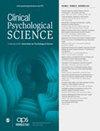Neuroticism Is Prospectively Associated With 30-Month Changes in Broadband Internalizing Symptoms, but Not Narrowband Positive Affect or Anxious Arousal, in Emerging Adulthood
IF 4.1
2区 医学
Q1 PSYCHIATRY
引用次数: 0
Abstract
Elevated levels of Neuroticism/Negative Emotionality (N/NE) and, less consistently, lower levels of Extraversion/Positive Emotionality (E/PE) confer risk for pathological depression and anxiety. To date, most prospective-longitudinal research has narrowly focused on traditional diagnostic categories, creating uncertainty about the precise nature of these prospective associations. Adopting an explicitly hierarchical-dimensional approach, we examined the association between baseline variation in personality and longitudinal changes in broad and narrow internalizing-symptom dimensions in 234 emerging adults followed for 2.5 years, during the transition from older adolescence to early adulthood. N/NE was uniquely associated with increases in broadband internalizing—the core cognitive and affective symptoms that cut across the emotional disorders—and unrelated to the narrower dimensions of positive affect and anxious arousal that differentiate specific internalizing presentations. Variation in E/PE and several other Big Five traits was cross-sectionally but not prospectively related to longitudinal changes in specific internalizing symptoms. Exploratory personality-facet-level analyses provided preliminary evidence of more granular associations between personality and longitudinal changes in internalizing symptoms. These observations enhance the precision of models linking personality to internalizing illness, highlight the centrality of N/NE to increases in transdiagnostic internalizing symptoms during a key developmental chapter, and set the stage for developing more effective prevention and treatment strategies.在成年初期,神经质与宽频内化症状的30个月变化有关,但与窄带积极情绪或焦虑唤醒无关
神经质/消极情绪(N/NE)水平的升高和外向性/积极情绪(E/PE)水平的降低(不太一致)会增加病理性抑郁和焦虑的风险。迄今为止,大多数前瞻性纵向研究都狭隘地集中在传统的诊断类别上,造成了这些前瞻性关联的确切性质的不确定性。采用明确的层次维度方法,我们对234名新生成人进行了为期2.5年的随访,从青春期过渡到成年早期,研究了人格基线变化与广义和狭义内化症状维度纵向变化之间的关系。N/NE与宽频内化(跨越情绪障碍的核心认知和情感症状)的增加有独特的联系,与区分特定内化表现的积极情感和焦虑唤醒的狭窄维度无关。E/PE和其他几个大五特征的变化是横断面的,但与特定内化症状的纵向变化没有前瞻性关系。探索性人格层面分析提供了初步证据,证明人格与内化症状的纵向变化之间存在更细粒度的关联。这些观察结果提高了将人格与内化疾病联系起来的模型的准确性,强调了在关键的发育阶段,N/NE对跨诊断内化症状增加的中心作用,并为制定更有效的预防和治疗策略奠定了基础。
本文章由计算机程序翻译,如有差异,请以英文原文为准。
求助全文
约1分钟内获得全文
求助全文
来源期刊

Clinical Psychological Science
Psychology-Clinical Psychology
CiteScore
9.70
自引率
2.10%
发文量
35
期刊介绍:
The Association for Psychological Science’s journal, Clinical Psychological Science, emerges from this confluence to provide readers with the best, most innovative research in clinical psychological science, giving researchers of all stripes a home for their work and a place in which to communicate with a broad audience of both clinical and other scientists.
 求助内容:
求助内容: 应助结果提醒方式:
应助结果提醒方式:


